Related Research Articles

Dorado is a constellation in the Southern Sky. It was named in the late 16th century and is now one of the 88 modern constellations. Its name refers to the mahi-mahi, which is known as dorado ("golden") in Spanish, although it has also been depicted as a swordfish. Dorado contains most of the Large Magellanic Cloud, the remainder being in the constellation Mensa. The South Ecliptic pole also lies within this constellation.
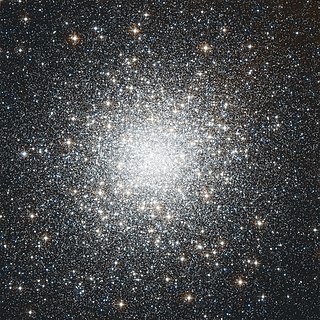
A globular cluster is a spheroidal conglomeration of stars that is bound together by gravity, with a higher concentration of stars towards its center. It can contain anywhere from tens of thousands to many millions of member stars, all orbiting in a stable, compact formation. Globular clusters are similar in form to dwarf spheroidal galaxies, and though globular clusters were long held to be the more luminous of the two, discoveries of outliers had made the distinction between the two less clear by the early 21st century. Their name is derived from Latin globulus. Globular clusters are occasionally known simply as "globulars".
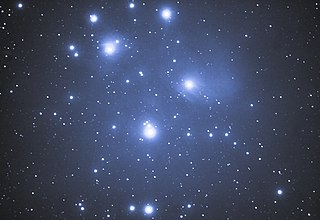
An open cluster is a type of star cluster made of tens to a few thousand stars that were formed from the same giant molecular cloud and have roughly the same age. More than 1,100 open clusters have been discovered within the Milky Way galaxy, and many more are thought to exist. Each one is loosely bound by mutual gravitational attraction and becomes disrupted by close encounters with other clusters and clouds of gas as they orbit the Galactic Center. This can result in a loss of cluster members through internal close encounters and a dispersion into the main body of the galaxy. Open clusters generally survive for a few hundred million years, with the most massive ones surviving for a few billion years. In contrast, the more massive globular clusters of stars exert a stronger gravitational attraction on their members, and can survive for longer. Open clusters have been found only in spiral and irregular galaxies, in which active star formation is occurring.

Star clusters are large groups of stars held together by self-gravitation. Two main types of star clusters can be distinguished. Globular clusters are tight groups of ten thousand to millions of old stars which are gravitationally bound. Open clusters are more loosely clustered groups of stars, generally containing fewer than a few hundred members, that are often very young. As they move through the galaxy, over time, open clusters become disrupted by the gravitational influence of giant molecular clouds. Even though they are no longer gravitationally bound, they will continue to move in broadly the same direction through space and are then known as stellar associations, sometimes referred to as moving groups.

The Large Magellanic Cloud (LMC) is a dwarf galaxy and satellite galaxy of the Milky Way. At a distance of around 50 kiloparsecs (163,000 light-years), the LMC is the second- or third-closest galaxy to the Milky Way, after the Sagittarius Dwarf Spheroidal (c. 16 kiloparsecs (52,000 light-years) away) and the possible dwarf irregular galaxy called the Canis Major Overdensity. Based on the D25 isophote at the B-band (445 nm wavelength of light), the Large Magellanic Cloud is about 9.86 kiloparsecs (32,200 light-years) across. It is roughly one-hundredth the mass of the Milky Way and is the fourth-largest galaxy in the Local Group, after the Andromeda Galaxy (M31), the Milky Way, and the Triangulum Galaxy (M33).

The Magellanic Clouds are two irregular dwarf galaxies in the southern celestial hemisphere. Orbiting the Milky Way galaxy, these satellite galaxies are members of the Local Group. Because both show signs of a bar structure, they are often reclassified as Magellanic spiral galaxies.
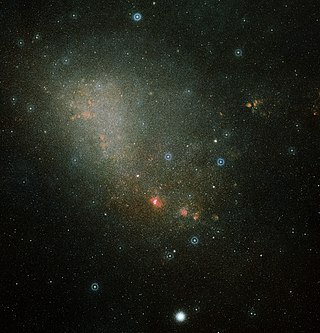
The Small Magellanic Cloud (SMC) is a dwarf galaxy near the Milky Way. Classified as a dwarf irregular galaxy, the SMC has a D25 isophotal diameter of about 5.78 kiloparsecs (18,900 light-years), and contains several hundred million stars. It has a total mass of approximately 7 billion solar masses. At a distance of about 200,000 light-years, the SMC is among the nearest intergalactic neighbors of the Milky Way and is one of the most distant objects visible to the naked eye.

Henrietta Swan Leavitt was an American astronomer. Her discovery of how to effectively measure vast distances to remote galaxies led to a shift in the scale and understanding of the scale and the nature of the universe. Nomination of Leavitt for the Nobel Prize had to be halted because of her death.

Knut Emil Lundmark, was a Swedish astronomer, professor of astronomy and head of the observatory at Lund University from 1929 to 1955.

NGC 1850 is a double cluster and a super star cluster in the Dorado constellation, located in the northwest part of the bar of the Large Magellanic Cloud, at a distance of 168 kly (51.5 kpc) from the Sun. It was discovered by Scottish astronomer James Dunlop in 1826.

Westerlund 2 is an obscured compact young star cluster in the Milky Way, with an estimated age of about one or two million years. It contains some of the hottest, brightest, and most massive stars known. The cluster resides inside a stellar breeding ground known as Gum 29, located 20,000 light-years away in the constellation Carina. It is half a degree from the naked eye Cepheid variable V399 Carinae.

Westerlund 1 is a compact young super star cluster about 3.8 kpc away from Earth. It is thought to be the most massive young star cluster in the Milky Way, and was discovered by Bengt Westerlund in 1961 but remained largely unstudied for many years due to high interstellar absorption in its direction. In the future, it will probably evolve into a globular cluster.
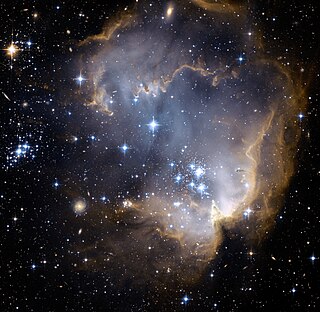
NGC 602 is a young, bright open cluster of stars located in the Small Magellanic Cloud (SMC), a satellite galaxy to the Milky Way. It was discovered on 1 August 1826 by Scottish astronomer James Dunlop. It is embedded in a nebula known as N90.

WOH G64 is an unusual yellow hypergiant star in the Large Magellanic Cloud (LMC) satellite galaxy in the southern constellation of Dorado.

A hypergiant (luminosity class 0 or Ia+) is a very rare type of star that has an extremely high luminosity, mass, size and mass loss because of its extreme stellar winds. The term hypergiant is defined as luminosity class 0 (zero) in the MKK system. However, this is rarely seen in literature or in published spectral classifications, except for specific well-defined groups such as the yellow hypergiants, RSG (red supergiants), or blue B(e) supergiants with emission spectra. More commonly, hypergiants are classed as Ia-0 or Ia+, but red supergiants are rarely assigned these spectral classifications. Astronomers are interested in these stars because they relate to understanding stellar evolution, especially star formation, stability, and their expected demise as supernovae. Notable examples of hypergiants include the Pistol Star, a blue hypergiant located close to the Galactic Center and one of the most luminous stars known; Rho Cassiopeiae, a yellow hypergiant that is one of the brightest to the naked eye; and Mu Cephei (Herschel's "Garnet Star"), one of the largest and brightest stars known.
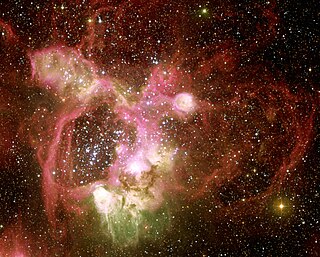
N44 is an emission nebula with superbubble structure located in the Large Magellanic Cloud, a satellite galaxy of the Milky Way in the constellation Dorado. Originally catalogued in Karl Henize's "Catalogue of H-alpha emission stars and nebulae in the Magellanic Clouds" of 1956, it is approximately 1,000 light-years wide and 160,000-170,000 light-years distant. N44 has a smaller bubble structure inside known as N44F. The superbubble structure of N44 itself is shaped by the radiation pressure of a 40-star group located near its center; the stars are blue-white, very luminous, and incredibly powerful. N44F has been shaped in a similar manner; it has a hot, massive central star with an unusually powerful stellar wind that moves at 7 million kilometers per hour. This is because it loses material at 100 million times the rate of the Sun, or approximately 1,000,000,000,000,000 tons per year. However, varying density in the N44 nebula has caused the formation of several dust pillars that may conceal star formation. This variable density is likely caused by previous supernovae in the vicinity of N44; many of the stars that have shaped it will eventually also end as supernovae. The past effects of supernovae are also confirmed by the fact that N44 emits x-rays.

Westerlund 1 W26 or Westerlund 1 BKS AS is a red supergiant located at the outskirts of the Westerlund 1 super star cluster. It is one of the largest known stars and the most luminous supergiant stars discovered so far with radius calculated to be in excess of a thousand times the solar radius, and a luminosity of over 200,000 times the solar luminosity. If placed at the center of the Solar System, its photosphere would engulf the orbit of Jupiter.
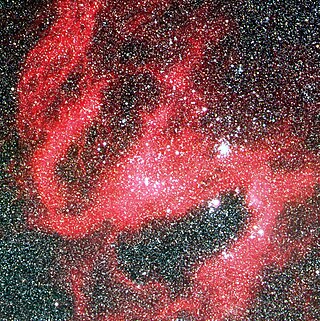
N119 is a spiral-shaped H II region in the Large Magellanic Cloud. Its dimensions are large, at 131 x 175 pc. It contains several luminous stars including S Doradus, LH41-1042, and LMC195-1. Its peculiar S-shaped structure is difficult to explain with classical models.

In astronomy, a period-luminosity relation is a relationship linking the luminosity of pulsating variable stars with their pulsation period. The best-known relation is the direct proportionality law holding for Classical Cepheid variables, sometimes called the Leavitt Law. Discovered in 1908 by Henrietta Swan Leavitt, the relation established Cepheids as foundational indicators of cosmic benchmarks for scaling galactic and extragalactic distances. The physical model explaining the Leavitt's law for classical cepheids is called kappa mechanism.
Dante Minniti is an astronomer born in Santa Fe, Argentina on December 1, 1962. He has devoted his career to the study of stellar populations, stellar evolution, globular clusters, galaxy formation, gravitational microlensing, exoplanets and astrobiology. He has been member of the SuperMACHO Team since 2001 and leader of the VVV Survey along with Phil Lucas since 2006 and of its extended version, the VVVX Survey. He has also fostered new scientists, supervising 14 PhD students, 11 Master Students and 17 Postdocs. He is Full Professor and Director of the Astronomy Institute at Andrés Bello National University (UNAB), Chile.
References
- 1 2 3 4 "Bengt Westerlund (1921-2008)". Uppsala University. Archived from the original on 28 December 2014. Retrieved 9 May 2015.
- 1 2 3 4 "In Memoriam: Bengt Westerlund" (PDF). ESO.org. Archived from the original (PDF) on 24 September 2015. Retrieved 9 May 2015.
- ↑ Archinal, Brent; Hynes, Steven (2003). Star Clusters. Willmann-Bell. p. 195. ISBN 0943396808.
- ↑ Westerlund, B. E.; Olander, N.; Hedin, B. (1981). "Supergiant and giant M type stars in the Large Magellanic Cloud". Astronomy & Astrophysics Supplement Series. 43: 267–295. Bibcode:1981A&AS...43..267W.